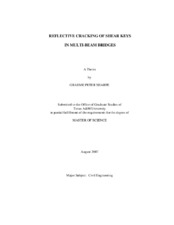| dc.description.abstract | Multi-beam bridges made from precast concrete box girders are one of the most
common bridge types used in the United States. One problem that affects these bridges
is the development of longitudinal or reflective cracks on the road surface because of
failure of the shear keys. Some states have attempted to correct this problem by
redesigning the shear key or adding post-tensioning, but the problem persists in many
new bridges.
The purpose of this study is to investigate why these shear key failures are
occurring. This project studies two types of box girder designs, the common
Precast/Prestressed Concrete Institute (PCI) box girder bridges and the Texas
Department of Tranportation (TxDOT) box girder bridge. In the past, reflective
cracking has occurred in bridges of both types.
The analysis procedure involves finite element analyses of bridge models with
realistic support and loading conditions, and comparing the PCI and TxDOT bridges.
The results indicate that both PCI and TxDOT box girder have sufficient strength to
resist cracking from vehicular loads, but uneven temperature changes and shrinkage strains cause high tensile stresses in the shear key regions and lead to reflective cracking.
The analyses showed the highest stresses were often times near the supports, rather than
at midspan.
Past studies have proposed using larger composite deck slabs, transverse posttensioning,
or full-depth shear keys to prevent shear key failure. Composite slabs were
the most effective way to reduce high stresses in shear keys, and were effective for all
loading cases considered. Post-tensioning and full-depth keys also showed a reduction
in shear key stresses, but were less effective. | en |


